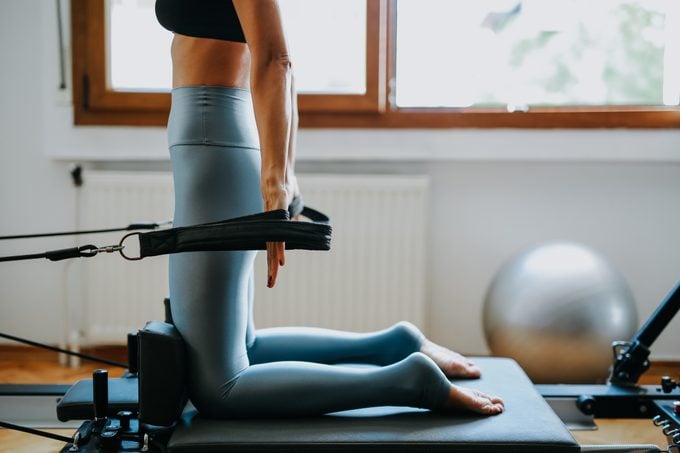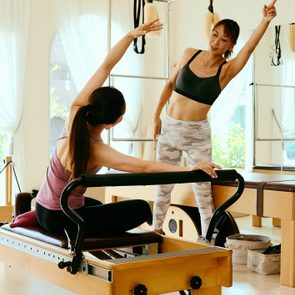Pilates 101: What Trainers Want You to Know Before You Take a Class
Updated: May 13, 2021
Pilates is a great exercise for beginners and advanced exercisers alike. Here's everything you need to know before you take a class.
Our editors and experts handpick every product we feature. We may earn a commission from your purchases.
On This Page
Who can do Pilates?
Pilates is a little like that woman at your gym with fancy workout gear and the sort of moves that put pro athletes to shame. In a word: intimidating.
Maybe that’s because tons of ultra-fit (and ultra-wealthy) celebrities swear by the practice. Or maybe it has to do with the fact that Pilates studios used to only exist in expensive cities, with classes costing an arm and a leg. The crazy machines probably play a role.
Truth time: The exclusive feel of Pilates is in the past.
These days, the practice is popping up everywhere: in small towns, in big gyms, even on your at-home fitness app of choice. And while the Pilates machines are way less complicated than they look, all you really need to do Pilates is a floor.
It’s high time we all admit that this mode of exercise is great for experienced exercisers and beginners alike.
A whole-body approach
“What I love about Pilates is it is a physical fitness method that is holistic,” says Tabatha Koylass, owner and master teacher at TabPilates in Chicago. “It is extremely holistic in terms of its ability to address everything: strength, flexibility, stability, mobility, breath, and the mind-body connection.”
Pilates is great not only for improving fitness but also for cultivating body awareness, which allows you to do all kinds of activities safely.
It’s also scalable for any fitness level. “We can give progressions or modifications depending on the person’s level,” says Davina Wong, master instructor at Club Pilates in Los Angeles.
Learn more about what Pilates is, how it works, and what you need to know before taking your first class.
The history of Pilates
Pilates was developed by Joseph Pilates in the 1920s. According to the Pilates Method Alliance, German-born Pilates was traveling in a circus troupe in England when World War I broke out. He was interned for the rest of the war.
During this time, he developed his exercise method and gained experience teaching exercise to others in the camp. At some point, he developed an apparatus to help address physical dysfunction and injury.
In 1926, Pilates immigrated to the United States. Here, he further developed his apparatus, which would later be known as the reformer. He designed his exercise regimen, dubbed Contrology, to be done on it.
In the 1930s, Pilates developed a reputation for fixing dancers’ injuries and developed mat exercise programs.
Contrology, which we now call Pilates, was created to transform people’s physical health. The goal: elevate people to a higher level of health, awareness, and overall well-being.
Pilates strongly believed in the union of body and mind during exercise. It’s a key tenant of the practice to this day.
Physical benefits of Pilates
Pilates offers major benefits to the body, including improving strength, flexibility, stability, mobility, and the mind-body connection.
Pilates moves focus on functional movements and core strength. Form is paramount, and regular practice can improve your posture and ability to do other activities with the best form and proper coordination.
Not only that, but Pilates is a great way to lose weight and beat workout boredom. That’s why it’s one of the best workouts for people who hate exercise.
Mental benefits of Pilates
It may be physical activity, but Pilates comes with mental benefits too.
The practice focuses on pairing breath with movement, and this slow, intentional breathing can help reduce tension and stress, Wong says.
That’s why people often report that not only do they feel better physically and mentally when they do Pilates, but they also sleep better, she says.
It’s also a practice in concentration and mindfulness—being in the moment.
“You’re not just mindlessly lying down and moving,” Wong says, “but really focusing on every single thing you do.”
This probably won’t come naturally to you at first, but as you practice Pilates more and more, you’ll be able to home in on that concentration and become more focused.
Classic Pilates exercises
Pilates classes can be classical, meaning that they only use the exercises developed by Joseph Pilates, or they can be more of a Pilates hybrid, which combines tenets of Pilates and other modalities, like barre.
You’ll get the benefits of Pilates from either, but if you want to take Pilates in its purest form, look for a teacher who is trained in the classical Pilates methodology.
Some basic Pilates moves you’ll find in most beginner classes include:
-
The roll up
-
Leg circles
-
Single-leg stretch
-
Teaser
-
Spine twist
-
Corkscrew
You’ve likely seen these done in workouts but maybe didn’t know they were Pilates moves.
Though you may come across some of the 34 exercises Joseph Pilates included in his workout, many of them will not be taught in a beginner class.

Is Pilates right for you?
“Pilates is excellent for not just beginners but even people who don’t really know how to move,” Koylass says.
That’s because it teaches body awareness and proper form—things we all should learn if we want to excel at a sport or even just move through life without hurting ourselves.
“People are able to take Pilates and transfer it to all the other stuff they do, everything from sitting to walking to other sports and fitness activities that it also helps to support and enhance,” Koylass says.
Even if you take a few Pilates classes and ultimately decide it’s not your thing, Koylass says you’ll have learned so much about your body that you hadn’t known before.
People of all ages can also benefit from Pilates. Koylass works with her older clients to maintain muscle mass and keep up the strength and stability it takes to do things like walk or stand up without assistance. It can be a great tool to keep people moving independently later in life.
Just one note: as with any exercise program, if you have any health concerns or preexisting conditions or injuries, you’ll want to make sure you’re cleared with your doctor before trying Pilates.
Pregnant women should also talk with their doctors before starting a Pilates practice. You might get the OK to do the workout with caveats so you avoid any moves that could harm you or the baby.
Things to know before your first Pilates class
You could jump right into a Pilates workout, but it’s good to know what you’re getting into before you start—plus some advice for getting more out of the practice.
Instructors say you need to know following seven facts before you take your first class.
Give class your undivided attention
When you’re just starting out, it’s critical to pay attention to your teacher’s cues and instructions, Wong says.
If you’re taking class virtually and you’re on your phone or yelling at your kids mid-workout, “you may miss a cue, do something incorrectly, and possibly get hurt,” she says.
Plus, the nature of Pilates—the movements require concentration and full focus on the body’s positioning and alignment—means that paying attention is a must if you want to reap the benefits.
It’s a full-body workout
“In any Pilates workout, you can expect a full-body workout that’s low-impact,” Wong says. “You’ll sweat, and it’s going to take a lot of concentration, control, and focus on the breath and alignment.”
You’re not going to get that out-of-breath cardio high that you’d get from an indoor cycling class or HIIT workout. But it’ll be challenging in a different way, and your muscles will definitely feel it the next few days.
“Even in the lowest-level class, when you do movements that look simple, you’ll realize they’re actually really hard,” Wong says. If you feel like you’re hurting yourself or something is off, definitely let your instructor know.
Slow and intentional movement is key
Pilates is meant to be done slowly.
“You want to really concentrate on controlling your movements, not just swinging your arms or legs around,” Wong says.
Actively think about each movement as you do it, focusing on how your body is positioned, how it feels, and what muscles you’re engaging throughout.
Breathing is important
Similar to yoga, pairing your breath with your movements is an essential part of Pilates.
Deep, intentional breathing helps you be more mindful and focus on your movements and how your body feels. It helps relieve tension (some which you may not even realize you’re holding), Wong says.
Deep breathing from the diaphragm is also the best way to properly engage the core, which you’ll be doing a ton throughout a Pilates session.
You may use a mat or reformer—or both
“Mat Pilates” is exactly what it sounds like: Pilates done on an exercise mat. These classes will incorporate some of the classical moves, and a hybrid class may include some yoga-like stretches and maybe other body weight and cardio moves.
The apparatus Joseph Pilates created, the reformer, is still a big part of many Pilates classes. You’ve probably spotted it in Pilates studios. It’s the machine that looks, admittedly, like a cross between a bed frame and torture device.
The reformer has a moving carriage (the part you sit or lie down on) that’s attached to springs. The springs create resistance, so they make it easier or harder to move the carriage. See? No torture involved.
“Higher resistance can be more or less challenging, depending on the movement,” Wong says.
Pilates instructors recommend learning the basics of Pilates on the mat before taking a class on a reformer so that you’re already comfortable with the exercises and know how it feels to do them properly.
But don’t be fooled: mat Pilates is still just as challenging, if not more so, Koylass says.
There are other types of Pilates equipment, like a Cadillac (a version of a reformer), a chair, and smaller props such as balls and rings. The last two might pop up in a beginner class, but you won’t need to think about most Pilates equipment until you’ve progressed to more advanced levels.
Tight clothing is best
Form-fitting clothes are best for Pilates simply so that they don’t get in the way when you’re moving. Yoga pants, yoga unitards, and form-fitting tops are all good options.
If you’re using a reformer, loose clothing can become a safety issue if it gets caught in the machine, Wong says.
Some clothing, like running shorts or a baggy T-shirt, can also expose you mid-workout. You may not care about that if you’re practicing alone in your living room, but you’ll probably want to avoid flashing the class when going to a studio.
In the studio, instructors recommend wearing socks with grips on the bottom so you don’t slip on the floors (or have to walk barefoot in communal spaces).
Your studio may sell socks there, or you can order a pair from a brand like Toesox. If you prefer to go barefoot, that’s fine, too, especially if you’re at home.
How to try Pilates
Learning Pilates in person with a qualified instructor is the best way to get a strong foundation for the practice and make sure you’re properly executing the moves—without risking injuries.
That’s not accessible for everyone, though. Luckily, there are many fitness apps that feature Pilates workouts. Alo Moves, FitOn, Peloton, and Glo are all great at-home fitness apps you can try.
If you’re starting Pilates at home, make sure to pay close attention to the instructor, follow the cues, and if something hurts or feels wrong, listen to your body and stop.
The goal, after all, is to get stronger, healthier, and feel good inside and out.












